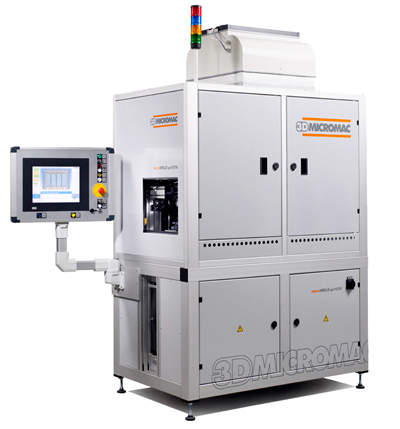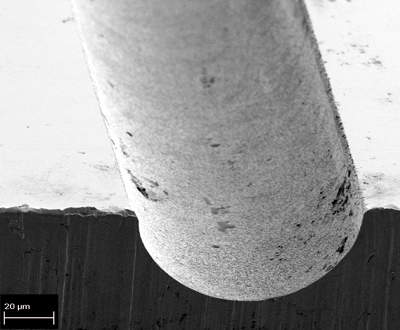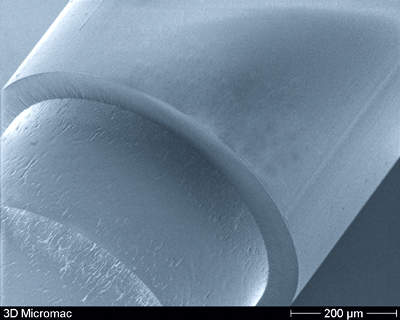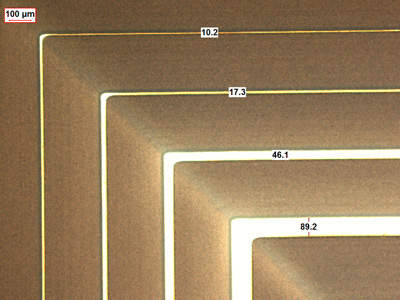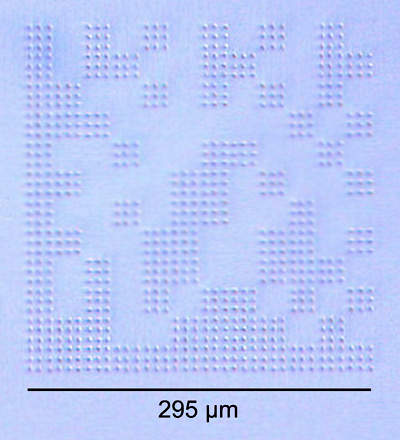3D-Micromac develops and manufactures state-of-the-art laser micromachining workstations for industry, research and science. These systems are often used in medical applications. Processes used with laser micromachining are micro drilling, signing, cutting, 2D and 3D structuring, welding, and marking of various materials and thin films.
All of these laser systems can be produced as highly precise stand-alone systems or integrated solutions for existing, fully automated production lines.
Laser micromachining of medical instruments
The manufacturing of medical instruments and implants is characterised by smaller and smaller structures as well as the demand for the highest precision in terms of surface quality, absence of burr, and materials residues. While established fabrication technologies increasingly face their limits, laser micromachining provides optimum pre-conditions for the required quality and precision since machining is accomplished in a contactless fashion and the extent of the heat-affected zone is very small.
Extremely precise positioning systems and innovative beam-delivery concepts, as well as numerous process monitoring methods, offer the highest possible process reliability and maximum speed of machining. The utilisation of lasers possessing the highest beam quality ensures the minimum of damage to the material and marginal materials loss. Machining in controlled atmosphere is possible at the customer’s request.
As a qualified partner, 3D-Micromac is also ready to develop new processes and technologies, or custom systems that meet customers’ demands.
3D-Micromac’s portfolio includes powerful equipment technology for manifold laser machining tasks.
Laser welding systems for cochlear implants or blood-cell analysis cartridges
Depending on the application, continuous wave (CW) lasers or pulsed solid-state lasers can be used for micro welding. Materials frequently used for laser micro welding are copper, steel titanium alloys, and polymer. 3D-Micromac can provide laser welding systems for manufacturing of cochlear implants and blood-cell analysis cartridges.
Laser drilling of cannulas, nozzles, implants and micro filters
Due to their excellent focusability, lasers are almost perfectly suited for the drilling of very fine holes. For the drilling of plastics excimer lasers are utilised, while the machining of metals and semiconductors is accomplished with DPSS laser sources or picosecond lasers. Blind holes as well as clearance holes can be obtained.
A particularly large area of potential development is the usage of novel helical drilling heads for generating of micro holes (diameter >50µm) with precisely controllable taper in up to 2mm thick metal sheets. With the advent of this technology, entirely new perspectives for design and functionalisation of cannulas, nozzles, implants and micro filters are opened.
Laser cutting of tubes and blades
For laser micro cutting of surgical instruments (for example, for minimal-invasive surgery) and implants, foils and wires can be cut on the 10µm scale. Moreover, foils and tubes can be machined with cutting widths well below 20µm; microstructures and 3D objects possessing a resolution of just a few microns can be generated.
Our lasers can also be used in the cutting of plastics masks or metal stencils. For machining of metals and ceramics, solid-state lasers (ps, ns) are suited best, while plastics and glasses are commonly machined with excimer or CO2 lasers.
Laser micro structuring and selective ablation
Lasers are, based on the outstanding ability to narrowly focus them, capable of extremely precisely and even selectively ablating materials from metals, ceramics, polymers or multilayer stacks. Machining in this range is preferably performed with short-pulsed or ultra-short-pulsed lasers.
The latter tools allow for the generation of the smallest possible microstructures (<15µm), the fabrication of 3D objects, and layer-by-layer ablation of coatings. These technologies are utilised for the removal of plastic coating from surgical instruments or for the manufacturing of catheters.
Using this technology, superficial structures in the micron range can also be realised; for example, for the optimisation of the ingrowing behaviour of implants or in micro fluidics.
Bio-compatible marking of metals, ceramics and transparent materials
For implants and medical instruments it is mandatory to generate a micro engraving free of bulging. Moreover, it has to be ensured that no germs of other materials’ residues are generated or dissolved. Advantages over conventional processes include minimised marking size, fraud-resistant and indelible labelling, and marking that is free of corrosion. In the case of transparent materials it is possible to generate the marking content with particle-free intra-glass engraving technology.


